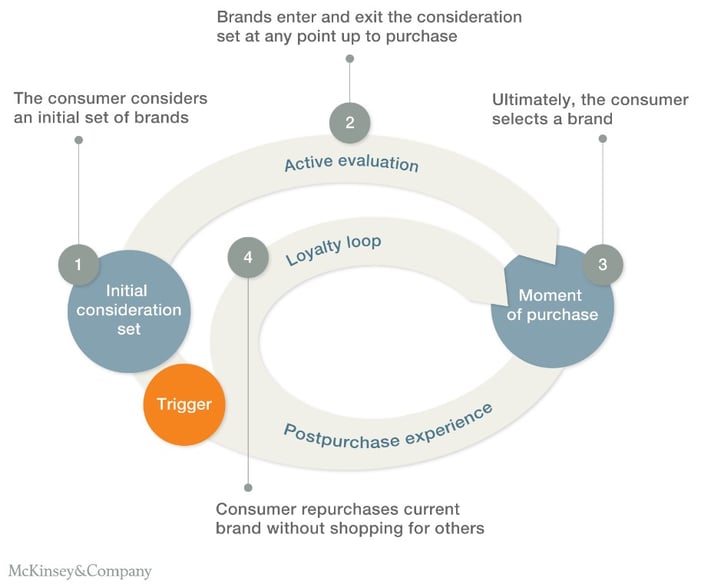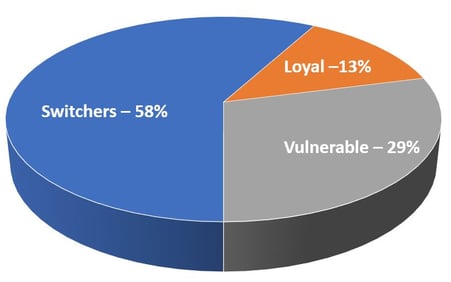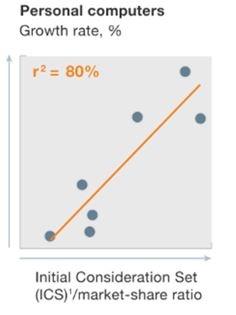I just read a fascinating report from the McKinsey consultancy that explores customer loyalty. It highlited that:
- "New technologies and greater choice are changing how consumers are thinking and acting"
- "In the digital world, your consumers can't help but shop around"
My first reaction was, “this is a B2C study, so it won’t really apply to Industrial B2B sales.” But as I read the report I started to see parallels to what our industrial marketer customers are experiencing. They are finding that their buyers are shopping around more frequently. It seems that even in the industrial world, brand loyalty is declining due to the rise of online comparison tools.

In this post, we will examine the study’s results through the lens of industrial marketing. I’ll look at how the complexity of industrial sales actually makes it more likely that your customers will consider your competitors. Finally, I will share the report’s recommendations on how to battle back against waning loyalty in the context of industrial marketing.
Top Level Findings
Based on a dataset of actual consumer purchases, the study found that only 13% of consumers were truly brand loyal. That means that 87% were open to overtures from competitors. Not all of those 87% switched brands, but they were open to it.
This chart below shows that in aggregate, 87% of consumers considered alternative brands for their purchases and 58% actually made the switch. The other 29% were considered “vulnerable”, in that they considered switching, but decided to repurchase their former brand.

Inside the mind of an industrial buyer
You may be thinking, “Well, that’s consumers and they don’t have anyone to answer to, so they can change their minds on a whim. Industrial buyers have complex purchase patterns with multiple sign-offs, so we are safe.”
But are you safe? Let’s say that your purchasers identify a comparable product at a lower price. In today’s world of online pricing tools, it’s almost impossible for them not to find such a product. What is their motivation to stick with your brand? Consider the motivation of an industrial buyer. Most industrial buyers, including specifiers such as engineers, are motivated more by fear of ordering the wrong item than by the gains they might experience by switching. This definitely works in your favor if you are the incumbent brand.
On the other hand, failing to investigate a lower-cost supplier presents the buyer with a risk that their boss will ask why it wasn’t investigated. This is a different sort of risk, a risk that they look incompetent or lazy. That motivation is also powerful. When the fear of looking lazy is high, and the effort to investigate a new supplier is low because the pricing and reviews are all available online, then evaluating switching becomes more compelling.
Not every category of industrial goods is easy to evaluate. For example, design software or custom machinery are difficult products to assess. Actuators and sensors are (mostly) less so. Despite the intuition that consumers would avoid investing the effort to evaluate switching products with complex purchase processes, the McKinsey study found that these decisions were also open to switching behavior with categories like automobiles and personal computers exhibiting high shopping behavior. So for those of you who market products involving complex purchases, you are best off to assume that every purchase will be reviewed in detail.
Getting your Brand into the Initial Consideration set is Critical
Once your buyer is considering switching, how important is it tha t your brand makes it into the first set of alternatives? Pretty freakin’ important. Check out this chart (to the right) from the study. It shows a very strong correlation between the growth rate of a company compared to how often that company’s products were included in the initial consideration set – ie, at the top of the funnel.
t your brand makes it into the first set of alternatives? Pretty freakin’ important. Check out this chart (to the right) from the study. It shows a very strong correlation between the growth rate of a company compared to how often that company’s products were included in the initial consideration set – ie, at the top of the funnel.
Now, it’s a little more nuanced than that. The consideration growth indicator (CGI) is actually a function of whether a brand is in the initial consideration set divided by the company’s market share. So for example, if your brand is #4 in the market, but you get included in as many initial consideration sets as the #1 brand, your company’s sales will grow faster than the leader. In fact, the McKinsey consultants say that this single element, which they call “CGI”, explains “a full 60 to 80 percent of the variation in sales growth”.
Many industrial marketers don’t think much of branding. They consider their sales process to be the key to unlocking revenue. However, the Internet has forever changed how people research and buy, and branding is a key part of that process. As Adrian Nash, VP Sales and Marketing at ENGINEERING.com says, “If you don’t think this is happening in your industry, prepare to lose.”
The truth is, its very difficult to determine exactly how your brand will make its way into your target customers' initial consideration set. They might search for the terms that you are winning through your SEM techniques. Or they might search for your products or company if they have heard of your brand.
While we may all now understand the rising importance of marketing in driving revenue growth, this research is the first that I’ve seen to convincingly put a number on just how important marketing is in general, and specifically, how important it is to get your brand into the initial consideration set.
This is a very big deal.
Does this mean industrial marketers should spend more on brand awareness?
Most industrial marketers (70%) in 2017 are measured on leads whereas only 48% are measured on web traffic or other awareness metrics. However, marketers have told us that they understand that they cannot generate leads unless they invest in awareness as well.
So where to place your budget – on lead generation or on awareness?
Marketers need to take some budget away from short term lead-generation activities, such as trade shows and events, and move it towards awareness and market positioning activities. For example, if you are not ranking on your key search terms, you need to get some stories published from credible sites that link to your company’s web site. Similarly, webinars present a valuable way for you to get your sales engineers in front of a technical audience to explain your company’s unique value. And of course, banner advertisements and video also provide a way to ensure that your brand is repeatedly imprinted on the minds of engineers and buyers.
This is not an easy balancing act when you are near the end of the quarter and have to hit your lead goals. That said, investing in awareness advertising to get your products into the initial consideration set will pay off in future quarters.
Until next time,
John




